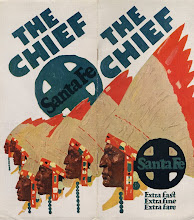This morning we had an early morning visit to the library by the French Ambassador to the United States Pierre Vimont, the French Foreign Trade Minister Anne-Marie Idrac, the Consul General of France at Miami Gaël de Maisonneuve, and others here in Miami to attend an important economic conference. In preparation for their visit, I had pulled a representative sampling of French materials in the library collection.
As Ms. Idrac had served as the President of RATP and SNCF (the public transportation departments for Paris and France) and others in attendance were involved in high speed train projects, I had pulled some materials related to railway service in France. These included a mid-nineteenth century French portfolio of color chromolithographic plates illustrating the interior decoration and design plans for the emperor’s royal train car, a small booklet about the railway line between Paris and Orléans published in 1908, a spiral-bound book with an aluminum-foil cover about the use of new alloys and materials in building modern trains, and an American children’s book with a beautiful color page spread of a speeding streamlined train from the 1930s.
There was also a sampling of various French world’s fair materials on the table, including several postcards from the Exposition international de l’Est de la France and portfolios from the Exposition internationale des arts décoratifs et industriels modernes (1925: Paris, France).
The architectural connection between the styles of the pavilions built for that latter fair and the Art Deco hotels here in Miami Beach did not go unnoticed. There were also a few rare Art Deco illustrated books and bindings for the visitors to peruse.
As always, some of our incredible propaganda materials were also laid out for their consideration. The visitors had the chance to look over a rare children’s book designed to teach young French children the alphabet even as they learned about their fathers’ participation in the Great War, 1914-1918.
We also had some propaganda pieces from the Second World War, some lampooning the German occupiers; others promoting allegiance to the collaborationist Vichy government.
One could not help but feel the cruel irony of reading such laudable sentiments as “One for all, and all for one” and “Long live France” in a propagandistic alphabet book produced by the Vichy regime. That same alphabet book also carried such insidious messages for children on other pages encouraging them to “punish the traitors”!
Of course, no tour of our French materials would have been complete without a review of some of the stunning pochoir portfolios in our collection. The pochoir (or “stencil work”) technique was popularized by French publishers in the “roaring twenties” and was used in deluxe edition illustrated books and in oversized portfolios promoting patterns for haute couture fashion, textiles, wallpaper, and designs to be applied to porcelains. The pochoir process required the creation of individual stencils for each color image in an illustration and the painstaking hand-application of brilliant gouache paints one after another. While the pochoir technique produced brilliant color images unmatched by any other contemporary industrial printing process, because it was so labor-intensive and expensive it quickly fell from fashion following the Stock Market crash of 1929 and the onset of the Great Depression.
GIFT OF RICHARD P. SCHICK














I'm sorry I missed such remarkable presentation.
ReplyDelete